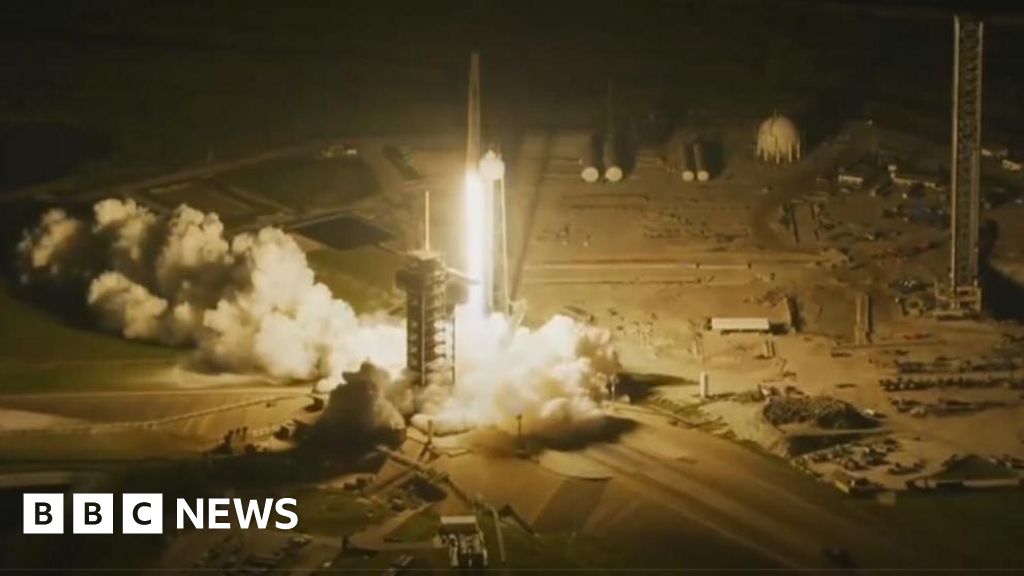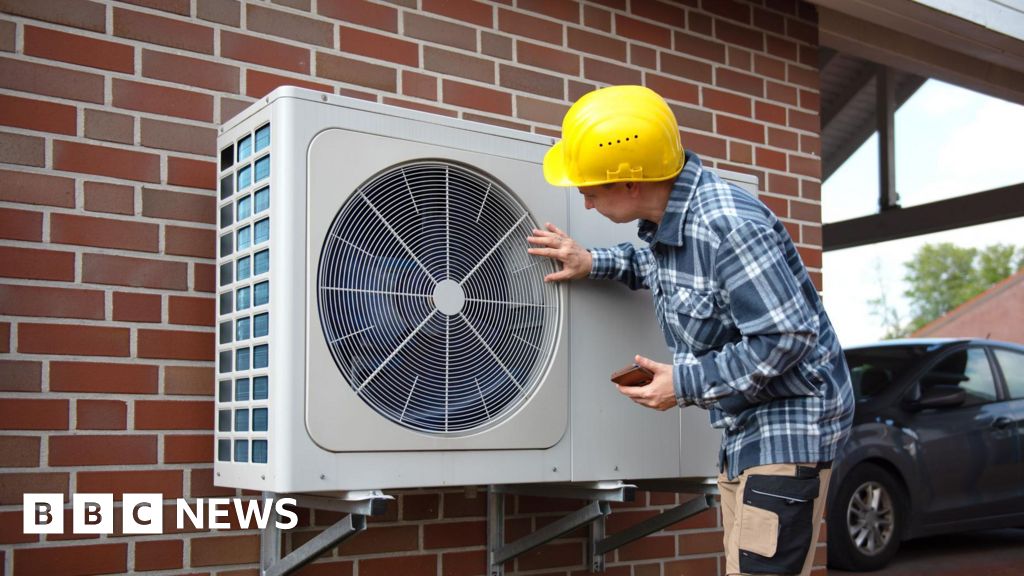


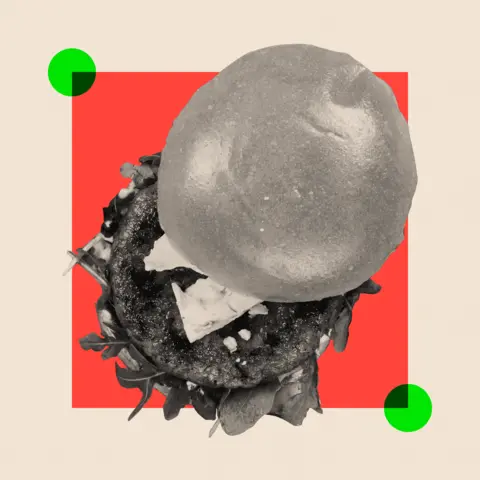 BBC
BBC
Inside an anonymous building in Oxford, Riley Jackson is frying a steak. The perfectly red fillet cut sizzles in the pan, its juices releasing a meaty aroma. But this is no ordinary steak. It was grown in the lab next door.
What's strangest of all is just how real it looks. The texture, when cut, is indistinguishable from the real thing.
"That's our goal," says Ms Jackson of Ivy Farm Technologies, the food tech start-up that created it. "We want it to be as close to a normal steak as possible."
Lab-grown meat is already sold in many parts of the world and in a couple of years, pending being granted regulatory approval, it could also be sold in the UK too - in burgers, pies and sausages.
Unlike so-called vegetarian meat, which is already available in UK supermarkets - from fake bacon rashers made from pea protein to steaks made of soy, and dyed bright red to resemble the real thing - lab-grown meat is biologically real meat, grown from cow cells.

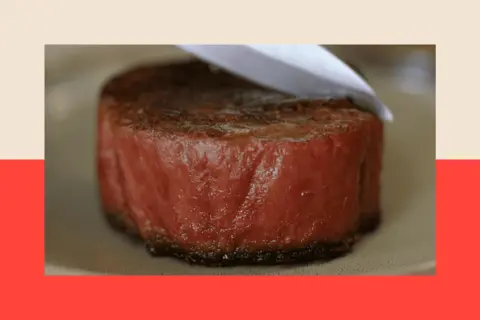 Ivy Farm Technologies
Ivy Farm Technologies
The lab-grown steak from Ivy Farm Technologies has a texture indistinguishable from regular steak
To some, this could be a smart technological fix for a growing environmental problem: the rise in planet-heating gases caused, in part, by the rapid and growing demand for meat.
But others argue that the environmental benefits of lab-grown meat, officially known as cultivated meat, have been oversold. Some critics say that more effort should instead be expended on reducing meat consumption, instead of looking to a technology fix.
Then there are questions around the ultra-processed nature of this meat, which some also worry will be produced by a handful of multinational companies.
So now, with dog food made from meat that was grown in factory vats having already gone on sale in the UK earlier this year and with the possibility of lab-grown food for humans becoming available sooner than expected - the debate has never been more prescient.
Nor has the question: to grow or not to grow?
Curbing greenhouse gas emissions
Global demand for meat is growing. According the the UK's Food and Agriculture Organisation, meat production has increased fivefold since the 1960s and reached around 364 million tonnes in 2023.
Producing 1kg of beef can generate planet-heating greenhouse gases, equivalent to roughly 40kg of carbon dioxide, though estimates can vary depending on the type of production.
A study published in Nature Food in 2021 concluded that food production was responsible for a third of global greenhouse gas emissions. Cattle also burp planet-heating methane gas, plus they require water and land.

 Ivy Farm Technologies
Ivy Farm Technologies
The BBC's Pallab Ghosh witnessed Ivy Farm's lab-grown steak being cooked but was unable to sample it as it is not yet approved
Tim Lang, a professor of food policy at City St George's, University of London argues that the issue is a ticking environmental time bomb. "The situation is absolutely dire," he says.
"Politicians are fearful of engaging with the issue. They don't want to take on the meat and farming industry, nor do they wish to risk unpopularity by enacting policies that would reduce meat consumption."
Lab-grown meat has been marketed as part of a solution. Its advocates claim that it can meet the growing demand for meat with much less carbon emissions and land use, plus it can help governments hit certain targets.
In the UK, for example, a 2021 independent review for the Department for the Environment Food and Rural Affairs (Defra) has called for a 30% reduction in meat consumption by 2032 to meet the country's net zero target.
Lab-grown sausages, eel and caviar
The science behind lab-grown meat is also relatively straightforward. Researchers take cells from a farm animal and grow more of them in a dish. When they have enough, they are put into ever larger vats until they have enough to produce a meat product.
Turning this into something that people want to eat is trickier. Each company has its own closely guarded secret sauce. But in the main, the cells are developed in a cocktail of nutrients, which encourage them to grow in the right way, after which other ingredients are sometimes added to boost the nutritional values.
The result is a paste, which is then processed and mixed with other foods such as soy to make it look, feel and taste more like meat. There are also plans to produce fish-like products this way, including eel and even caviar.

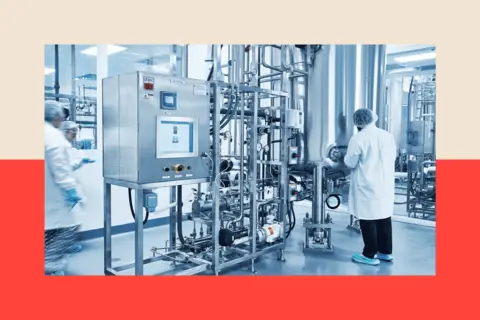 Good Meat, Inc.
Good Meat, Inc.
The laboratory at GOOD Meat - its cultivated chicken is approved for sale in Singapore and the United States
Ivy Farm Technologies is currently the only UK business that has applied for approval. If granted, its first products won't be steaks but burgers and sausages.
It plans to combine cultivated mince, (which is cheaper and easier to produce than trying to replicate the taste of a real steak) with regular mince to create a blended cow-cultivated beef burger.
"If you want to make a sustainable difference, you have to go for mass production and burgers are where the masses are," says the firm's CEO Dr Harsh Amin. "If you blend our cultivated meat with animal derived meat, you are [still] reducing the carbon footprint."
"Hope not hard evidence"?
Ivy Farm claims this type of meat can lead to significant reductions in greenhouse gas emissions and other environmental benefits. Other companies make similar claims, but these are based more on hope than hard evidence, according to Dr John Lynch, of Oxford University, who has carried out a comprehensive, independent assessment of the climate impact of lab-grown meat.
"There have not been any accurate climate assessment studies because production is not happening at large scale at the moment," he adds.
The problem with comparing the climate impact of lab-grown meat with agricultural production is that there is little data and many variables.
Growing cells in vats requires energy, as does producing the chemicals that are added. Businesses keep the details of their processes secret, for perfectly legitimate reasons, so it is hard to produce a single figure for the climate cost of cultivated meat.

 Farm Images via Getty
Farm Images via Getty
Methane from cows disappears from the atmosphere after about 12 years but the CO2 used to produce lab-grown food may stay around for longer
Dr Lynch has assessed the data available in scientific papers and found that the best-case cultivated meat carbon footprints were as low as 1.65 kg of CO2 per kg, which is better for the climate than traditional beef production.
However, if a lab-grown meat process needs a lot of energy, some estimates put the figure as high as 22kg of CO2 per kg, making its climate advantage less certain.
Then there is the fact that the cows' methane gas burps disappear from the atmosphere after 12 years or so, whereas the CO2 produced to grow the lab meat continues to do its damage for much longer.
So, in the long run, it may be a bad idea to replace cows with high energy lab-grown production, according to Dr Lynch's assessment. Yet that may be counter-balanced by the fact that cultivated meat production would require far less land.
The bottom line is that the environmental advantages of lab-grown beef over cattle farming is a closer run thing than its advocates argue - but it is likely to have the edge as production methods scale up and become more efficient, according to Dr Lynch.
"For beef, it is quite viable for cultured meat to come out on top," he argues. "But I don't think it is the same story for chicken and pork, which convert their feed into meat more efficiently than cattle."
Lab-grown salmon in fine dining restaurants
Singapore became the first country to allow the sale of cell-cultivated meat for human consumption in 2020. This was followed by the United States three years later and Israel in 2024.
UK firms have complained that the regulatory approvals process is too slow for them to keep up with overseas competitors. But sales in those countries have in the main been peripatetic, with many firms only offering tastings or serving it in upmarket restaurants for short periods.

 Good Meat, Inc.
Good Meat, Inc.
Good Meat's lab-grown chicken was served at a restaurant in Washington, DC
This is largely because manufacturers are not able to mass-produce their products in sufficient quantities or as cheaply as traditional meat.
In the US, four companies have received some form of regulatory approval for their lab-grown chicken, pork fat and salmon. Salmon from Wildtype, for example, is now served at Kann, a fine-dining restaurant in Oregon, while Good Meat's chicken was introduced at a restaurant in Washington, DC.
The response from consumers so far has been "optimistic and curious", according to Suzi Gerber who is the executive director of the US Association for Meat, Poultry and Seafood Innovation.
What farmers and fishermen say
Some parts of the US cattle industry have, however, expressed opposition to the technology and lobbied for it to be banned, though other livestock firms have remained neutral or been supportive.
The National Cattlemen's Beef Association and several state-level organisations publicly oppose bans, perhaps in case it sets a precedent for banning other scientific advances, such as bio-engineered food stock for cattle.
The cultivated meat industry says that their products should have no effect on the livestock industry – people will always prefer real meat over artificial. The role of the new technology is, they say, to meet the demand that livestock production is unable to.
The seafood industry has also shown openness: for example, the US National Fisheries Institute recognises cultivated seafood as part of a broader domestic production of on-land fish, like aquaculture.
Will "high-protein slurry" really save the planet?
Ellen Dinsmoor is chief operating officer of Vow, a Sydney-based firm that sells cultivated Japanese quail products in Japan. It recently received approval to sell in Australia too.
Unlike some cultivated meat firms, Vow is not trying to copy normal meats. Instead, the firm has chosen quail because fewer people know what it is supposed to taste like.
"What we have to do is produce a really delicious product that people want," she explains. "A little later we can sell it on nutrition, for example we can add healthy omega-3 oils found only in salmon into chicken. And then if we can do all that at a fraction of the price, this is where it becomes interesting to consumers."
This is all part of a strategy to create a stable high-end market, which could in time enable investment in producing food that is less posh and in larger quantities.
But for some critics, the potential benefits of this technology for the environment, or indeed for the poorest communities in the world, are being lost.

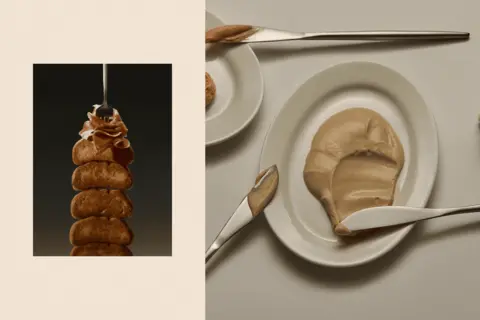 Vow
Vow
Unlike other lab-grown meat companies, Vow isn't trying to copy traditional meats - its products include Vow Japanese Quail Foie Gras and Japanese Quail Whipped Pate
Some of the start-up companies involved are driven by delivering swift returns to their investors, argues Dr Chris van Tulleken, author of Ultra-Processed People, which can be more easily done by producing high-priced products in high-income countries.
A simpler, cheaper and easier option, he argues, would be to persuade people in both developed and emerging countries to eat less meat.
"It is all very well to propose to people that they should eat a high-protein slurry to keep themselves well," he argues, "but… I don't think it is something we should impose on already marginalised groups of people."
He also worries that the emergence of cultivated food is an acceleration of a long-term trend away from environmentally sustainable, locally sourced, whole foods and toward factory mass-produced fare. "And at the moment the process is pretty energy intensive."
But like it or not, lab-grown meat is here. To some, it's a healthier option with less cholesterol, no animal suffering - and a clever solution to a pressing environmental problem. To others, those benefits may have been overblown.
For all the promises and potential about helping the world, however, most people choose food for more personal reasons, namely how it tastes and how affordable it is. That, more than anything, may well decide its future.
BBC InDepth is the home on the website and app for the best analysis, with fresh perspectives that challenge assumptions and deep reporting on the biggest issues of the day. And we showcase thought-provoking content from across BBC Sounds and iPlayer too. You can send us your feedback on the InDepth section by clicking on the button below.

 9 hours ago
1
9 hours ago
1

